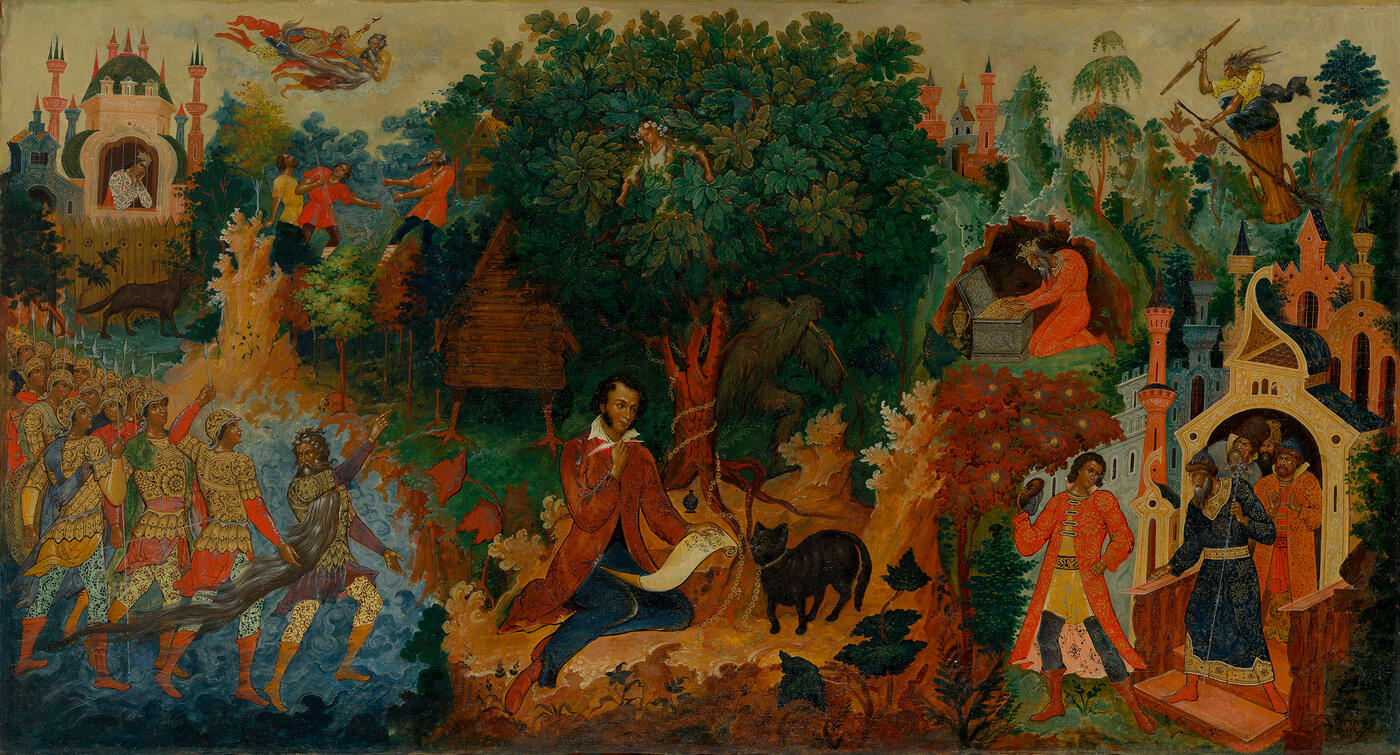Important European Collection of Russian Art, plus Other Properties
30 May 2020

43. BUTORIN, DMITRY (1891–1960)
U lukomoriia dub zelionyi..., signed, inscribed in Cyrillic "Palekh" and dated 1933.
Oil on canvas, laid on cardboard, 81 by 150 cm.
30,000–40,000 GBP
Provenance: Possibly, collection of the writer Boris Pilniak (1894–1938), Moscow.
Important private collection, Europe.
Literature: Possibly, G. Zhidkov, Pushkin v iskusstve Palekha, Moscow-Leningrad, 1937, p. 159, mentioned in the text.
Authenticity of the work has been confirmed by expert Yu. Rybakova.
U lukomoriia dub zelionyi..., a picture by one of the most celebrated Palekh artists, Dmitry Butorin, is a very rare and extremely interesting example of the use of the renowned lacquer-work miniature composition to create a large-scale easel painting. Lukomorye is a fictional land in Russian folklore and nowadays is usually associated with Pushkin’s fairy-tale poem Ruslan and Lyudmila, to which “A green oak stands by Lukomorye” is the opening line of the prologue.
The artist first turned to this Pushkin-inspired subject in 1925, shortly after the founding of the Artel of Ancient Painting for former Palekh icon painters who were forced to look for new ways of realising their creative potential. Subsequently, one of them, Alexander Kotukhin, was to recall: “When we organised the artel, we only had a collection of Pushkin’s works in Sytin’s edition for seven people. This largely explains why, at that time, we based most of our miniature paintings on Pushkin’s stories.”
During the artel’s first ten years, Butorin created a whole gallery of works that, in one way or another, rang the changes on depictions of Lukomorye. According to the artel’s documents, starting in 1925 with the painting of his Tea Caddy and a casket, the artist painted three more versions of this composition in the following year, two more in 1927, five in 1928, another two in 1929, four in 1930, and three in 1932. Caskets and small cases from the series are now to be found in the collections of the Russian Museum, the Museum of Decorative and Applied Arts, the Nizhny Novgorod and Ivanovo Art Museums and the Palekh Museum, as well as the Pushkin Apartment Museum on Moika.
The literary origin of these and similar works attracted a striking interest in Palekh art among writers in the late 1920s and early 1930s. Many prominent men of letters began to converge on Palekh, including Ilya Ehrenburg, Valentin Kataev, Nikolai Zarudin, Boris Pilnyak and Paul Couturier. Alexei Tolstoy and Maxim Gorky, Henri Barbusse and Romain Rolland were fascinated by the art of the Palekh miniatures.
In particular, in his 1933 article on the Palekh craftsmen, the writer Efim Vikhrev noted Butorin’s latest and, in his view, most successful composition on the Lukomorye theme: “in the latest version, Butorin, with his characteristic refinement, developed the introduction to the poem [Pushkin’s Ruslan and Lyudmila,] without ignoring a single word. In the first version there were only the hut on hen’s legs, the oak tree, the cat on a golden chain, the wood spirit, the knights and the mermaid, whereas the latest version is the full and definitive interpretation of Pushkin’s text. Since the Lukomorye poem states, “And there I stayed, and drank of mead...”, Butorin was right in thinking: “‘I’ is Pushkin and, dressing Pushkin in a gold-embroidered kaftan, he placed him, attentive and thoughtful, near the oak tree with a scroll in one hand and a goose quill in the other. Butorin progressed through the lines of the poem without neglecting a single word ... (he) also radically altered the composition stylistically ... in the first version, the mermaid was reclining, in the latest she is sitting ... the oak is treated quite differently, it is presented more realistically and forms the emerald-coloured centre of the picture, around which, without overlapping each other and at the same time with purely Pushkinian conciseness, all the other elements of the picture are arranged” (Efim Vikhrev, Pushkin i Gorky v iskusstve Palekha, Novy mir, No. 9, 1933, p. 235).
It is highly likely to be this version that was transformed, with consummate elegance and slight alteration, into the painting. The transformation was probably initiated by a commission from Boris Pilnyak, who had repeatedly visited Palekh and in whose house the picture was seen, shortly before the writer’s arrest in 1937, by German Zhidkov (G.V. Zhidkov, Pushkin v iskusstve Palekha, Moscow-Leningrad, 1937, p. 159). Pilnyak was a close friend of Butorin’s, and he devoted to him – “a truly fine artist and a fine man at the dawn of cloudy youth, a lyric poet, altruistic in every way” – whole pages of his novel The Ripening of the Fruit, published in 1935 in the magazine Novy Mir.
Unlike his fellow writer, Efim Vikhrev, who valued the “concessions to realism” in this new departure in Butorin’s Lukomorye, Pilnyak, on the contrary, cherished the master’s perpetuation of the icon-painting tradition, which was still evident both in the composition’s actual design and in the development of the individual images and figures. What is more, he saw in that work not only the world of Pushkin’s imagery and a depiction of the poet, but also a self-portrait of the artist himself: “Dmitry Nikolaevich Butorin, who loved the sixteenth-century colouring of Russian icon painting, whereby he is strangely reminiscent of the Dutch masters, painted U lukomoriia dub zelionyi..., depicting himself alongside Pushkin in the image of the learned cat with its gold chain and gold-rimmed glasses” (B. Pilnyak, Sozrevanie plodov / Sobranie sochinenii v shesti tomakh, Moscow, 2004, vol. 6).
Notes on symbols:
* Indicates 5% Import Duty Charge applies.
Ω Indicates 20% Import Duty Charge applies.
§ Indicates Artist's Resale Right applies.
† Indicates Standard VAT scheme applies, and the rate of 20% VAT will be charged on both hammer price and premium.